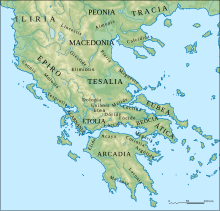Tymphaea

Tymphaea or Tymphaia (
Kingdom of Macedon, specifically Upper Macedonia, in the 4th century BC.[3]
History
Due to the fact that Greek
Kingdom of Macedon as part of Upper Macedonia.[3][6] The most famous native of Tymphaea was Polyperchon, regent of Alexander III (r. 336–323 BC). He was the son of Simmias, who was the ruler of the Tymphaioi in circa 370 BC.[7]
The Tymphaei were Greeks that belonged to the wider Molossian tribe.[1] They were one of the Epirote tribes of the north-western Greek group.[8] They worshipped Zeus under the name “Deipaturos” probably as the god of their mountain, Tymphe.[9]
See also
References
Citations
- ^ a b Hammond 1982, p. 276: "As we leave the coastal area, we may turn first to the middle and upper Haliacmon valley, where Elimeotis, Tymphaea and Orestis were inhabited by Epirotic tribes, or more correctly 'Molossian' tribes if the account in Strabo was derived from Hecataeus."
- ^ Hammond 1993, pp. 132–133: "Further, the tribes which Strabo termed "Epirotic" — Orestai, Tymphaioi, Elimiotai, Lynkestai and Pelagones — are likely to have spoken the same dialect as the Molossians, to whom they were in some sense related."
- ^ a b Hammond 1994, p. 206: "When Philip annexed Elimea, Orestis, and Lyncus and territory up to Lake Lychnitis, reorganized the administration, and planted towns such as Heraclea Lyncestis, he was in a position to recruit and train infantry from these areas, ready for service perhaps by 352 B.C.; and similarly from Tymphaea, annexed probably in 350 B.C., infantry ready for service by 345 B.C."
- ^ Georgiev 1973, p. 247: "The region north of this line, which comprises Epirus as far as Aulon, in the north (including Paravaia, Tymphaea, Athamania, Dolopia, Amphilochia and Acarnania), western and northern Thessaly (Hestiaeotis, Perrhaebia, Tripolis) and Pieria, i.e. approximately the whole of northern and north-western Greece, is characterized by the following features. 1. Absence of pre-Hellenic place-names. [...] All the principal names north of the line are of archaic Greek origin. [...] Thus in the region defined just above, roughly northern and northwestern Greece. [...] Since Greek place-names are very dense in that region and they have a very archaic appearance, one may suppose that the proto-Greeks were settled in it during many centuries and even millennia."
- ^ Hammond 1993, [p. 141] "We see here the origins of the Tymphaioi (named after Mt. Tymphe) Orestai, Lynkestai and Pelagones, who practiced this way of life and were each a cluster of tribes."; [p. 143] "... the "Tymphaioi" were so named from the mountain Tymphe."
- ^ Hatzopoulos 1996, p. 249: "Finally, the fourth meris gathered the Upper Macedonian ethne (Lynkestai, Tymphaioi, Atintanes), to which Pelagonia (presumably with Derriopos), in other words the western part of the former strategia of Paionia, was added."
- ^ Pleket, Stroud & Strubbe 1994, p. 124: "Polyperchon, one of Alexander's generals and later regent (319 B.C.), son of Simmias who ruled the Tymphaioi ca. 370 B.C."
- ^ Hammond 1967, p. 538.
- ^ Hammond 2000, p. 6.
Sources
- Benveniste, Émile (2016) [1969]. Dictionary of Indo-European Concepts and Society. Chicago, IL: Hau Books (University of Chicago Press). ISBN 978-0-9861325-9-9.
- Georgiev, Vladimir I. (1973). "The Arrival of the Greeks in Greece: The Linguistic Evidence". In Crossland, R. A.; Birchall, Ann (eds.). Bronze Age Migrations in the Aegean; Archaeological and Linguistic Problems in Greek Prehistory: Proceedings of the First International Colloquium on Aegean Prehistory, Sheffield. London: Gerald Duckworth & Company Limited. pp. 243–253. ISBN 978-0-7156-0580-6.
- Hammond, Nicholas (2000). "The Ethne in Epirus and Upper Macedonia". The Annual of the British School at Athens. 95: 345–352. S2CID 140559037.
- Hammond, Nicholas Geoffrey Lemprière (1994). Collected Studies. Vol. III. Amsterdam: Hakkert.
- Hammond, Nicholas Geoffrey Lemprière (1967). Epirus: The Geography, the Ancient Remains, the History and the Topography of Epirus and Adjacent Areas. Oxford: The Clarendon Press.
- Hammond, Nicholas Geoffrey Lemprière (1993). Studies Concerning Epirus and Macedonia Before Alexander. Amsterdam: Hakkert. ISBN 9789025610500.
- Hammond, Nicholas Geoffrey Lemprière (1982). "CHAPTER 40 ILLYRIS, EPIRUS AND MACEDONIA". In Boardman, John; Hammond, Nicholas Geoffrey Lemprière (eds.). The Cambridge Ancient History: The Expansion of the Greek World, Eighth to Sixth Centuries B.C. Vol. III, Part 3 (2nd ed.). Cambridge: Cambridge University Press. pp. 261–285. ISBN 0-521-23447-6.
- Hatzopoulos, Miltiades V. (1996). Macedonian Institutions Under the Kings: A Historical and Epigraphic Study, Volume 1. Athens: Kentron Hellēnikēs kai Rōmaïkēs Archaiotētos. ISBN 978-960-7094-90-2.
- Pleket, H. W.; Stroud, R. S.; Strubbe, Johan (1994). Supplementum Epigraphicum Graecum, Volumes 44–45. Amsterdam: J.C. Gieben. ISBN 9789050635288.
Further reading
- Hazlitt, William (1851). "Tymphaea". The Classical Gazetter. p. 360. Archived from the original on 2012-10-11.
